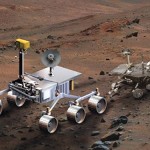
Coloured drops on a Mottlecah leaf. Image: Murdoch Universit
Eucalyptus macrocarpa is a gold mine for nanotechnology applications.
Eucalyptus macrocarpa (Mottlecah) is a native to south west WA with large bright red and pink flowers, giving it the name “˜Rose of the West.’ But this attractive plant also possesses self-cleaning and water repellent properties, which could make it ideal for nanotechnology.
The first clue, according to Dr Gerrard Poinern from Murdoch University, was the silvery colour of the leaves. “When I joined Murdoch University in Perth, I realized that this awkward looking plant with beautiful spectacular flowers had whitish slivery leaves and sit stood out from the rest of the foliage on campus,” he said.
“So I decided to have a closer look by using advance microscopy.”
A closer look revealed that the silvery leaves are covered in wax, which forms nano-sized lumps and pillars. This coating causes water to form droplets that roll over the surface of the leaves, picking up any dirt as they go.
These properties are known as super-hydrophobic and self-cleaning, and are shared by the lotus plant. A number of self-cleaning and antibacterial technologies are currently in development, having been inspired by the lotus plant.
“Being in Nanotechnology, one of the great works in that area is from Barthlott and Neinhuis about the lotus leaf and the micron/nano structures of the leaves’ surface,” Dr Poinern said. “So combining the above knowledge with a curious mind, I decided to investigate further.”
Dr Poinern and his team tested this self-cleaning property by coating the leaves with carbon black toner from a laser printer cartridge and watching water droplets remove the ink. This adaption probably developed as a way of surviving in arid areas, allowing Mottlecah plants to channel water to their roots.
The scientists also extracted the waxes from the leaves and discovered that they were capable of reassembly. When they coated laboratory slides with the wax, it formed the bumps and pillars originally observed on the leaf, effectively making the slide super-hydrophobic.
“The wax has a remarkable property of reassembling in the same fashion,” Dr Poinern said.
When the slides were placed in water, the buoyancy support from the wax meant they could carry a greater load than the uncoated slides. These properties could be used to keep microfluidity devices, which are used for advanced medical research and in testing for diseases, sterile.
Dr Poinern said there are many possible applications, “such as industrial coatings on pipe-lines, ships hulls and biomedical devices such as Lab on a chip.”






